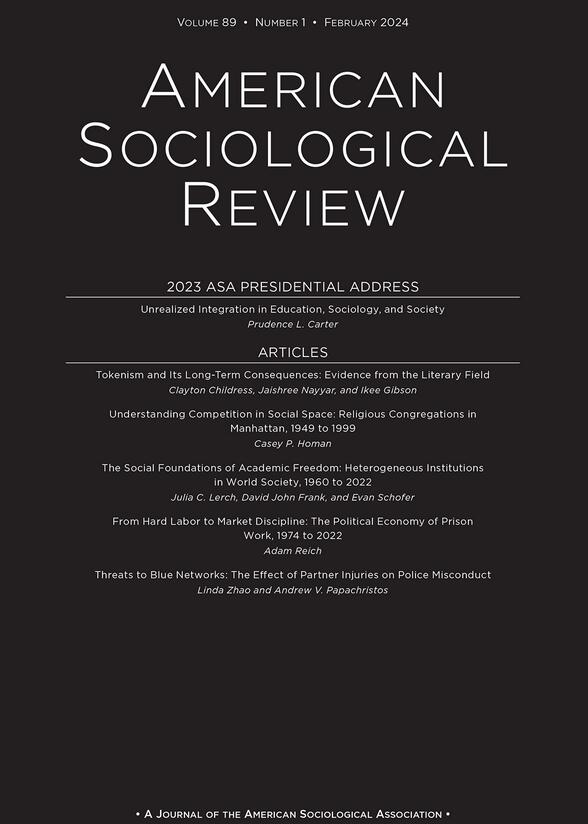超越金钱白化:墨西哥的种族等级制度和社会经济升级
IF 6.2
1区 社会学
Q1 SOCIOLOGY
引用次数: 4
摘要
一个核心的社会学主张是种族是一种社会建构;这方面的一个重要例证是种族分类如何受到人们社会经济地位的影响。在拉丁美洲和美国,社会经济地位较高的人比其他长相相似的人更有可能被归类为白人,这一模式的典型代表是“金钱变白”。然而,最近关于社会经济地位对种族分类影响的研究显示,结果不一致,有时取决于所使用的衡量标准。我们发展了一种广泛的社会理论,认为社会具有多个种族化的等级制度,不同的社会经济扶梯可能会将人们带到每个社会中地位更高的地方。然而,种族化的等级制度在不同的社会中有所不同,一些非白人的分类可能反映了一个向上运动的过程,而另一些则可能不是。我们使用2019年墨西哥种族歧视项目评估了墨西哥的这一过程,这是一项具有全国代表性的调查,包括高度准确的数字肤色评级、感知肤色评估以及受访者和访谈者的种族分类。我们发现,接受高等教育会增加受访者对梅斯提佐的自我分类。然而,那些拥有更多财富的人却被面试官“刷白”了。同时,受访者和面试官用更大的财富“减轻”了受访者的负担。我们认为,在不同的种族化等级制度中,社会经济地位可以不同地影响流动性,这表明种族是如何部分由阶级等其他社会结构构成的。本文章由计算机程序翻译,如有差异,请以英文原文为准。
Beyond Money Whitening: Racialized Hierarchies and Socioeconomic Escalators in Mexico
A core sociological claim is that race is a social construction; an important illustration of this is how racial classifications are influenced by people’s socioeconomic status. In both Latin America and the United States, someone with higher SES is more likely to be classified as White than others of similar appearance, a pattern epitomized by the expression “money whitens.” However, recent studies of the effect of SES on racial classifications show inconsistent results, sometimes depending on the measures used. We develop a broad theorization of societies as having multiple racialized hierarchies with different socioeconomic escalators potentially bringing people to higher-status locations in each one. Yet racialized hierarchies differ across societies, and some non-White classifications may reflect a process of upward movement while others may not. We assess this process in Mexico using the 2019 Project on Ethnic-Racial Discrimination in Mexico, a nationally-representative survey including highly accurate digital skin-color ratings, perceived skin-color assessments, and ethnoracial classifications by respondents and interviewers. We find that having higher education increases respondents’ self-classification as Mestizo. Yet those with greater wealth are “whitened” by interviewers. Simultaneously, respondents and interviewers “lighten” respondents with greater wealth. We argue that SES can differentially affect mobility in different racialized hierarchies, showing how race is constructed partly by other social constructs like class.
求助全文
通过发布文献求助,成功后即可免费获取论文全文。
去求助
来源期刊

American Sociological Review
SOCIOLOGY-
CiteScore
13.30
自引率
3.30%
发文量
35
期刊介绍:
The American Sociological Association (ASA) is a non-profit membership association established in 1905. Its mission is to advance sociology as a scientific discipline and profession that serves the public good. ASA is comprised of approximately 12,000 members including faculty members, researchers, practitioners, and students in the field of sociology. Roughly 20% of the members work in government, business, or non-profit organizations.
One of ASA's primary endeavors is the publication and dissemination of important sociological research. To this end, they founded the American Sociological Review (ASR) in 1936. ASR is the flagship journal of the association and publishes original works that are of general interest and contribute to the advancement of sociology. The journal seeks to publish new theoretical developments, research results that enhance our understanding of fundamental social processes, and significant methodological innovations. ASR welcomes submissions from all areas of sociology, placing an emphasis on exceptional quality.
Aside from ASR, ASA also publishes 14 professional journals and magazines. Additionally, they organize an annual meeting that attracts over 6,000 participants. ASA's membership consists of scholars, professionals, and students dedicated to the study and application of sociology in various domains of society.
 求助内容:
求助内容: 应助结果提醒方式:
应助结果提醒方式:


